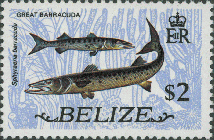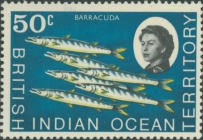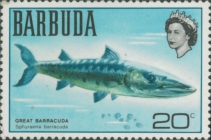Deep-Sea name details
Sphyraena barracuda (Walbaum, 1792)
159812 (urn:lsid:marinespecies.org:taxname:159812)
unaccepted
Species
marine, brackish, fresh, terrestrial
(of ) Catesby, M; Edwards, G. (1771). A catalogue of the animals and plants represented in Catesby's Natural History of Carolina. With the Linnean names. In: Edwards's (1771) edition of The Natural History of Carolina, Florida and the Bahamas Islands by Mark Catesby. Volume I: 100 pp., 100 pis; Volume II: 100 pp., 100 pis; appendix: 20 pp., 20 pis., available online at https://www.biodiversitylibrary.org/page/52786043 [details]
Description Found predominantly at or near the surface (Ref. 6949). Juveniles occur among mangroves, estuaries and shallow sheltered...
Description Found predominantly at or near the surface (Ref. 6949). Juveniles occur among mangroves, estuaries and shallow sheltered inner reef areas; adults occur in a wide range of habitats from murky inner harbors to open seas. Diurnal and solitary, but can also be found in small aggregations. Feeds on fishes (littoral schooling and coral-reef fishes), cephalopods and sometimes on shrimps (Ref. 9626). Commercially important in Guam but banned from sale in the West Indies because large adults often ciguatoxic. Rarely attacks humans, usually with one quick, fierce strike, which, although serious, is rarely fatal. Also caught with set-nets (Ref. 9768). Sold fresh. Utilzed also dried/salted (Ref. 9987). Although this species is ciguatoxic elsewhere throughout its range, it has not been reported to be poisonous in the eastern Atlantic (Ref. 6949). [details]
Froese, R. and D. Pauly. Editors. (2024). FishBase. Sphyraena barracuda (Walbaum, 1792). Accessed through: Glover, A.G.; Higgs, N.; Horton, T. (2024) World Register of Deep-Sea species (WoRDSS) at: https://www.marinespecies.org/deepsea/aphia.php?p=taxdetails&id=159812 on 2024-04-19
Glover, A.G.; Higgs, N.; Horton, T. (2024). World Register of Deep-Sea species (WoRDSS). Sphyraena barracuda (Walbaum, 1792). Accessed at: https://marinespecies.org/deepsea/aphia.php?p=taxdetails&id=159812 on 2024-04-19
Date
action
by
original description
(of ) Catesby, M; Edwards, G. (1771). A catalogue of the animals and plants represented in Catesby's Natural History of Carolina. With the Linnean names. In: Edwards's (1771) edition of The Natural History of Carolina, Florida and the Bahamas Islands by Mark Catesby. Volume I: 100 pp., 100 pis; Volume II: 100 pp., 100 pis; appendix: 20 pp., 20 pis., available online at https://www.biodiversitylibrary.org/page/52786043 [details]
context source (Deepsea) Intergovernmental Oceanographic Commission (IOC) of UNESCO. The Ocean Biogeographic Information System (OBIS), available online at http://www.iobis.org/ [details]
context source (HKRMS) Hong Kong marine fish database. <em>AFCD.</em> , available online at https://www.hk-fish.net/en/fish/introduction/ [details]
basis of record Robins, C. R.; Ray, G. C.; Douglass, J.; Freund, R. (1986). A field guide to Atlantic coast fishes of North America. <em>Houghton Mifflin Co. Boston.</em> 1-354. [details]
additional source Smith, J.L.B. & Smith, M.M. (1963). The fishes of Seychelles. Department of Ichthyology, Rhodes University. Grahamstown. [details]
additional source Randall, J. E. (1992). Red Sea Reef Fishes. <em>Immel Publishing.</em> [details]
additional source McEachran, J. D. (2009). Fishes (Vertebrata: Pisces) of the Gulf of Mexico, Pp. 1223–1316 in: Felder, D.L. and D.K. Camp (eds.), Gulf of Mexico–Origins, Waters, and Biota. Biodiversity. Texas A&M Press, College Station, Texas. [details]
additional source Froese, R. & D. Pauly (Editors). (2023). FishBase. World Wide Web electronic publication. version (02/2023)., available online at https://www.fishbase.org [details]
context source (Deepsea) Intergovernmental Oceanographic Commission (IOC) of UNESCO. The Ocean Biogeographic Information System (OBIS), available online at http://www.iobis.org/ [details]
context source (HKRMS) Hong Kong marine fish database. <em>AFCD.</em> , available online at https://www.hk-fish.net/en/fish/introduction/ [details]
basis of record Robins, C. R.; Ray, G. C.; Douglass, J.; Freund, R. (1986). A field guide to Atlantic coast fishes of North America. <em>Houghton Mifflin Co. Boston.</em> 1-354. [details]
additional source Smith, J.L.B. & Smith, M.M. (1963). The fishes of Seychelles. Department of Ichthyology, Rhodes University. Grahamstown. [details]
additional source Randall, J. E. (1992). Red Sea Reef Fishes. <em>Immel Publishing.</em> [details]
additional source McEachran, J. D. (2009). Fishes (Vertebrata: Pisces) of the Gulf of Mexico, Pp. 1223–1316 in: Felder, D.L. and D.K. Camp (eds.), Gulf of Mexico–Origins, Waters, and Biota. Biodiversity. Texas A&M Press, College Station, Texas. [details]
additional source Froese, R. & D. Pauly (Editors). (2023). FishBase. World Wide Web electronic publication. version (02/2023)., available online at https://www.fishbase.org [details]
 Present
Present  Inaccurate
Inaccurate  Introduced: alien
Introduced: alien  Containing type locality
Containing type locality
From other sources
Description Found predominantly at or near the surface (Ref. 6949). Juveniles occur among mangroves, estuaries and shallow sheltered inner reef areas; adults occur in a wide range of habitats from murky inner harbors to open seas. Diurnal and solitary, but can also be found in small aggregations. Feeds on fishes (littoral schooling and coral-reef fishes), cephalopods and sometimes on shrimps (Ref. 9626). Commercially important in Guam but banned from sale in the West Indies because large adults often ciguatoxic. Rarely attacks humans, usually with one quick, fierce strike, which, although serious, is rarely fatal. Also caught with set-nets (Ref. 9768). Sold fresh. Utilzed also dried/salted (Ref. 9987). Although this species is ciguatoxic elsewhere throughout its range, it has not been reported to be poisonous in the eastern Atlantic (Ref. 6949). [details]
| Language | Name | |
|---|---|---|
| Japanese | オニカマス | [details] |












